Kitesurf Basics: Mastering Kiteboarding Fundamentals
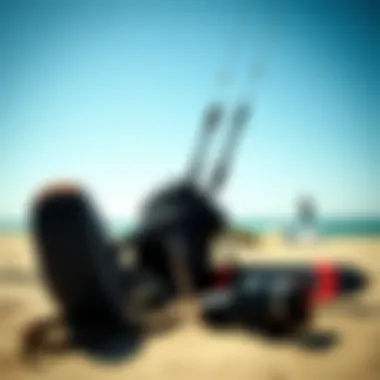
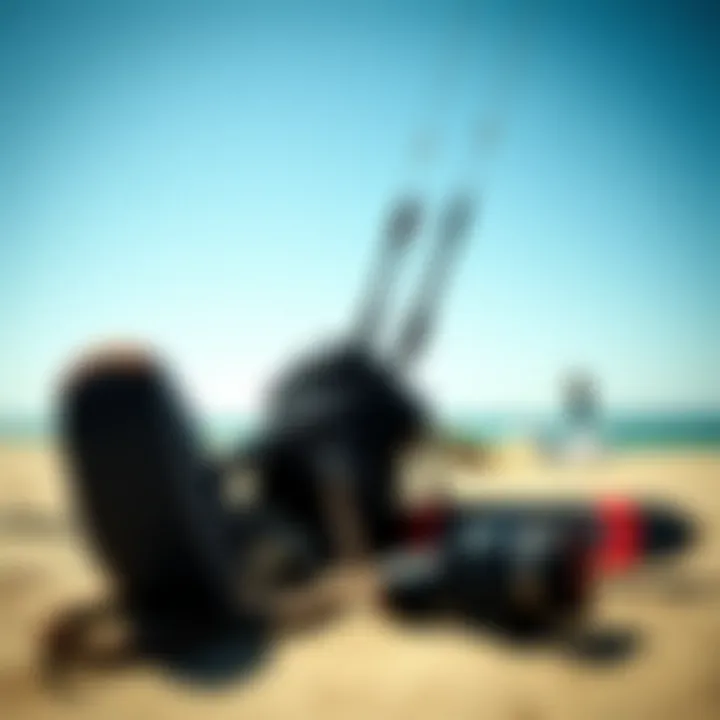
Intro
Kitesurfing combines the thrill of surfing with the power of wind. Whether you are a total rookie or someone who has been riding the wave for a while, getting to grips with kitesurfing's basics is essential for anyone looking to progress in the sport. This article serves as your go-to guide for understanding the key elements of kitesurfing, from choosing the right gear to mastering techniques that elevate your ride, and ensuring safety along the way.
The world of kiteboarding is rich with excitement yet demands a solid foundation of knowledge. Knowing your gear or understanding wind dynamics can make all the difference when you're out there on the water. In this article, we will break down all facets of kitesurfing into digestible sections, making it easier for enthusiasts of all skill levels to engage with the sport.
"The best kiteboarders are those who understand their equipment and the environment they are in."
Let’s kick things off with a deep dive into gear insights, where we will explore the essentials and latest advancements in the kitesurfing world.
Preface to Kitesurfing
Kitesurfing stands as a thrilling blend of surfing, windsurfing, and paragliding. This multi-faceted sport not only harnesses the wind's power but also requires the rider to master various skills, equipment, and environmental factors. Whether you're zooming across the water or launching high into the air, kitesurfing offers something for everyone—from the adrenaline junkie to those just looking to enjoy serene moments on the sea.
Understanding the fundamentals of kitesurfing is essential for anyone considering diving into this exhilarating sport. This segment outlines the crucial components that make kitesurfing both accessible and complex, while also highlighting the benefits it brings. First and foremost, kitesurfing promotes physical fitness; it engages multiple muscle groups, enhances balance, and boosts cardiovascular health. Moreover, it fosters an appreciation for nature, as riders must remain attuned to wind and water conditions.
Definition and Overview
Simply put, kitesurfing is the art of riding on a board while being propelled by a large parachute-like kite. Riders control the kite using a bar and lines, directing their movement across the water's surface. This sport can take many forms, from freeriding and trick riding to racing and wave riding, each with its unique style and challenges.
The allure of kitesurfing lies in its versatility. Riders can undertake diverse maneuvers, adapting to varying wind and water conditions. While a basic understanding of the techniques may lead to simple enjoyment, achieving a higher level of proficiency opens up an array of thrilling possibilities.
Historical Context
Tracing back to the late 20th century, kitesurfing has its roots steeped in a rich tapestry of human ingenuity. Various cultures have employed kites for different purposes, dating as far back as ancient China. In fact, kites were originally utilized for military and scientific applications long before evolving into a recreational activity.
The modern form of kitesurfing began to take shape in the 1970s, when pioneers began experimenting with kite designs. Fast forward to the 1990s, the sport gained significant traction with the introduction of inflatable kites which drastically enhanced stability and ease of use. By the early 2000s, kitesurfing had secured a place on the global stage, evolving into a vibrant community characterized by both competitive events and casual meetups.
Today, kitesurfing draws enthusiasts and newcomers alike, attracted by its exhilarating blend of skill, strategy, and connection with nature. From local beach gatherings to world-class competitions, the culture surrounding kitesurfing continues to flourish.
Essential Gear and Equipment
A solid understanding of the essential gear and equipment is vital in kitesurfing. Each piece plays a crucial role in ensuring a successful and safe ride, which can greatly enhance a rider's overall experience on the water. Choosing the right gear often makes the difference between an exhilarating adventure and a frustrating ordeal.
Every kitesurfer should take time to learn about the various components that make up the sport. From kites to boards, harnesses, and safety gear, knowing how each item works can help individuals tailor their setups to their specific needs.
Kites and Their Types
Inflatable Kites
Inflatable kites are among the most popular types of kites used in kitesurfing. The primary aspect that makes them so appealing is their ability to offer stability and control while in the air. Made of ripstop nylon with inflatable bladder systems, these kites become buoyant when filled with air, allowing for enhanced lift and performance.
One significant feature of inflatable kites is their range of sizes, which provides riders with options to adapt to different wind conditions. Larger kites are suited for lighter winds, while smaller kites perform better in stronger winds.
While the advantages are clear, there are a few drawbacks to be aware of. Inflatable kites tend to be bulkier when deflated, making them less portable compared to some alternatives. Nonetheless, their widespread popularity can be attributed to their versatility and ease of use, perfectly aligning with the objectives of both novice and seasoned kitesurfers alike.
Foil Kites
Foil kites are designed differently compared to their inflatable counterparts, featuring multiple cells that create an airfoil shape. These kites are well-regarded for their efficiency in low-wind scenarios, offering an excellent choice for those seeking extended sessions on less breezy days.
A key characteristic of foil kites is that they usually weigh less than inflatable types, meaning they can be more responsive in the water. Their unique design allows them to maintain lift even when the wind is not at optimal levels.
However, foil kites do come with disadvantages. They require more skill to launch and land effectively, which can pose challenges for novice riders. Additionally, they generally lack the robust depower capabilities that inflatable kites possess, making it essential for riders to be more attuned to the wind's behavior.
Boards: A Competitive Look
Directional Boards
Directional boards are crafted specifically for kitesurfers who like to surf on the waves. They resemble traditional surfboards and are intended to be ridden with the front facing the direction of travel. This design allows for smooth transitions and nimble maneuverability in the surf.
One of their significant aspects is their ability to handle various conditions. Directional boards excel in choppy waters or waves, making them a favorite among adventurous riders.
Despite their advantages, directional boards can be less versatile for flat-water riding. Riders who frequently switch between conditions might find themselves needing multiple boards to cater to their differing styles.
Twintips
Twintip boards are recognized for their symmetry, allowing riders to ride in either direction without the need to switch feet. This characteristic makes them a popular choice among beginners and intermediate kitesurfers. Their design promotes simplicity when learning new tricks or maneuvers.
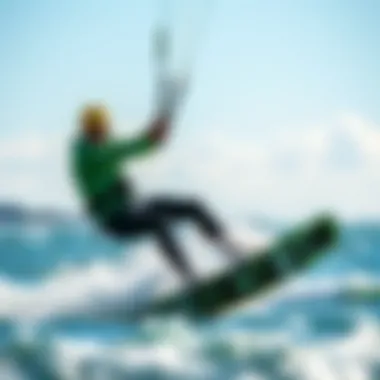
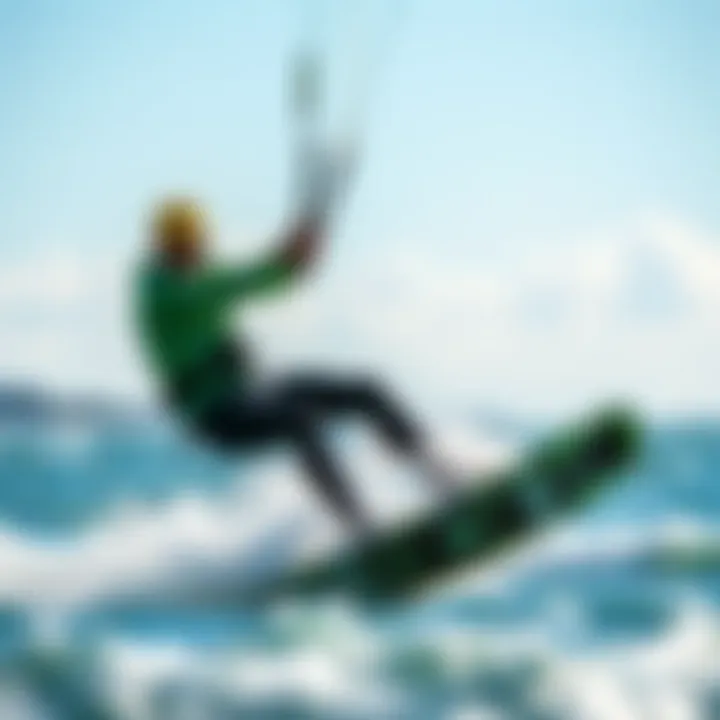
A notable point about twintips is how forgiving they are during landings, which can be a game changer for those just starting. Riders don’t need to worry as much about the board’s orientation, allowing them to focus more on their techniques instead.
However, twintips primarily excel in flat water conditions, so riders aiming to tackle waves may find them limiting. Understanding the characteristics of both types empowers riders to choose the best board for their specific kitesurfing aspirations.
Harness Options
Seat Harness
Seat harnesses are designed for those who prefer a lower center of gravity. Riders often find this style more comfortable, especially when engaging in intense maneuvers. They distribute pressure evenly across the pelvis, which can be beneficial during long sessions.
The seat harness's key characteristic is its coverage, providing more support for the lower back compared to other harness types. This feature can be a blessing for riders who tend to experience discomfort with traditional styles.
On the flip side, a seat harness may restrict mobility slightly more than a waist harness. Riders need to find a balance between comfort and freedom of movement based on their unique riding styles.
Waist Harness
Waist harnesses offer a blend of support and freedom, allowing for higher mobility during tricks and jumps. Positioned around the waist, these harnesses enable riders to move more freely, which is a significant advantage when performing advanced maneuvers.
This type is highly regarded for its ease of use and the slim profiles many come with. Riders often appreciate the sleek design that reduces bulkiness while still providing substantial support.
However, some may find that waist harnesses offer less back support than seat harnesses, particularly for those spending extended periods on the water. Each rider should weigh their priorities when deciding on the best option.
Safety Gear
Helmets
Helmets have become an essential item in the realm of kitesurfing, offering crucial protection from head injuries that can occur due to unexpected falls or collisions. The safety they provide is paramount, making every ride not only thrilling but safer.
A key characteristic of a good helmet is its lightweight construction, designed to minimize strain during rides while still providing robust protection. Additionally, helmets often come with features like ventilation and moisture-wicking liners for added comfort.
However, some riders may feel that wearing a helmet can limit their sense of freedom or connection to the elements. Nonetheless, wearing one should never be compromised, as the risk involved in kitesurfing can be too significant.
Impact Vests
Impact vests serve as a secondary layer of protection, primarily guarding against impacts that can arise from high-speed crashes. These vests are designed with padding to absorb shock and distribute the force across the body.
Their main advantage lies in not only protecting riders but providing insulation and flotation to some extent. This feature can help keep riders afloat if they find themselves in tricky waters.
Conversely, more advanced riders might find themselves preferring less bulky gear that offers more freedom in movements. Some impact vests can feel restrictive or heavy, depending on the style and design.
"Selecting the right equipment is not just about performance—it's a critical aspect for ensuring safety and enjoyment in kitesurfing."
Overall, the right essential gear and equipment are foundational in shaping an enjoyable kitesurfing experience. Understanding the differences and advantages of each piece empowers riders to carve out the optimal setup tailored to their individual needs.
Fundamental Techniques
The category of Fundamental Techniques forms the backbone of kitesurfing. It's essential for novices to grasp these concepts early, as they dictate how efficiently and safely one can maneuver through the waves. Mastering these techniques not only enhances the enjoyment of the sport but also builds confidence as riders progress. Focusing on the basics allows for a smoother transition to advanced maneuvers in the future, ensuring that each rider can harness the power of the wind effectively and respond to varying conditions with ease.
Launching the Kite
Launching the kite is arguably one of the most critical steps in kitesurfing. A successful launch means that the kite ascends smoothly into the sky without any tangles or crashes. Riders need to pay attention to wind direction and strength when preparing to take off. Establishing clear communication with a partner is also vital, especially for new kitesurfers. This collaboration can help prevent accidents and ensure a safe ascent. Practicing how to secure lines and use visual cues will instill a solid foundation for safer launches every time. A common tip here is to always launch and land your kite on the upwind side to minimize potential hazards.
Water Starts
The water start is a key moment when a rider transitions from being in the water to riding on the board. It can sometimes feel like a dance, with each movement needing to be fluid and precise. Learning to water start involves proper positioning of the kite, controlling the tension in the lines, and finding that sweet spot to pull the trigger on power. Being patient with oneself during this phase is crucial. Many beginners struggle initially, but with practice, it becomes second nature. Focusing on body positioning and building muscle memory will make water starts a breeze.
Riding Techniques
Edge Control
Edge control is about learning to angle the board against the water’s surface, allowing for greater speed and directional stability. It plays a decisive role in how well a rider can navigate waves and wind conditions. A primary characteristic of effective edge control lies in how the rider distributes their weight. By leaning back and pressing down on the heel edge, they can grip the water better. This technique is popular because it enhances speed while maintaining balance, lessening the likelihood of spills. A unique feature of edge control is its versatility; it allows for smooth transitions when dodging obstacles or changing direction, contributing significantly to the overall rider experience.
Speed Management
Managing speed involves understanding both the kite and the board to ensure a comfortable and enjoyable ride. Riders need to be aware of the wind's influence on their speed, as different conditions can lead to either sluggishness or overwhelming velocity. It's a bit of a balancing act; going too fast can lead to difficulties in control, while too slow can sap the fun. A crucial characteristic of speed management is the ability to adjust kite position relative to the wind direction. Riders must be able to cultivate a feel for the water and respond accordingly. An advantage of mastering speed management is the smooth gliding it creates, enabling a rider to maximize their ride enjoyment while minimizing potential wipeouts.
Turning and Jibe Execution
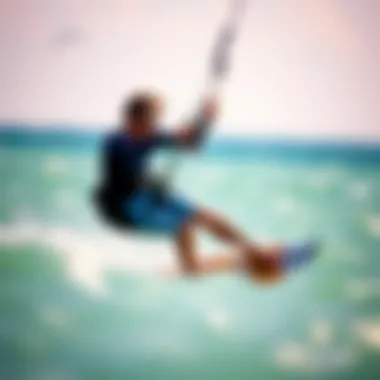
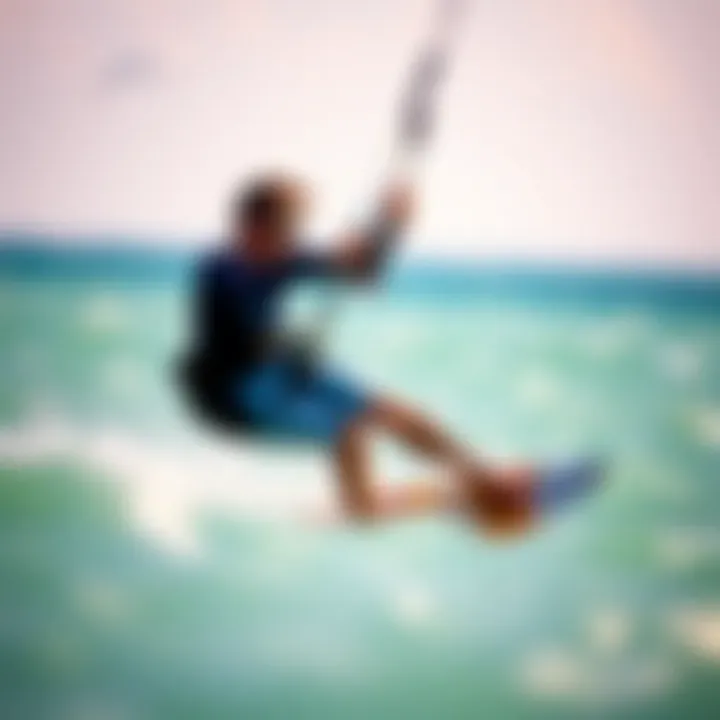
Executing turns and jibes involves smoothly changing direction while maintaining speed and control. These maneuvers require practice and a level of finesse, as they need careful attention to weight distribution and kite positioning. Good edge control during turns will keep the rider stable while allowing for a fluid motion to maintain momentum. With each turn, the rider learns to gauge how to manipulate their board and kite interaction effectively. As the rider becomes more comfortable, turning can become a highlight of the kitesurfing experience, showcasing the elegance and agility felt when gliding across the water.
"In kitesurfing, every foundational technique builds upon the previous. Master each one, and the thrill of the ride multiplies exponentially."
Confidently integrating these fundamental techniques opens up new horizons for any kitesurfing enthusiast, allowing each session on the water to be more meaningful. As skills develop, the passionate nature of kitesurfing becomes clearer, making each ride not only an expression of mastery but also a celebration of nature's elements.
Safety Considerations
Ensuring safety in kitesurfing is not just a good practice; it's essential for survival and enjoyment. As with any adventurous sport, the potential for accidents or mishaps exists, and understanding safety considerations can mean the difference between a thrilling ride and a dangerous situation. For kiteboarders, knowing how to navigate various conditions, prepare for emergencies, and practice good etiquette is crucial. This section delves into the key aspects of safety that every rider should be aware of while hitting the waves.
Understanding Wind Conditions
The wind is the lifeblood of kitesurfing. Without it, you might as well be at a picnic with a loaf of bread. But understanding wind conditions goes beyond just knowing if it's there. The strength, direction, and variability of the wind can greatly affect performance and safety.
- Wind Speed: Optimal wind speeds typically range from 12 to 25 knots. If it's too light, you’ll be sitting on your board looking foolish; too strong, and you could end up in a world of hurt. Check your local forecasts and use an anemometer to measure real-time conditions.
- Wind Direction: This plays a vital role in your potential hazards. Familiarize yourself with wind patterns specific to your chosen location. Onshore winds can be particularly dangerous, often pushing you directly towards the shore, while offshore winds can take you far from safety.
- Gustiness: Wind can be unpredictable, with gusts popping up like bad dreams. Always keep an eye on the horizon. If you notice dark clouds forming or sudden gusts, it's best to call it a day.
Emergency Protocols
Even the most seasoned riders can encounter unexpected challenges. That's why having a solid grasp on emergency protocols can help you react swiftly should trouble arise. Being prepared can greatly reduce risks associated with kitesurfing. Here are some protocols worth noting:
- Self-Rescue: This is a key technique every kiteboarder should master. Learn how to control your kite on the water and bring yourself back to shore in the case of a malfunction. Understanding how to relaunch your kite or use it as a flotation device can be a lifesaver.
- Buddy System: If you’re riding solo, it’s true you are the hero of your own story, but the best stories often involve sidekicks. Having a partner who understands the sport can increase safety. They can help keep an eye on each other and be your first line of defense in emergencies.
- Emergency Signals: Establish clear signals with your riding buddies. For instance, waving arms can mean ‘help’, while raising your board might signify that you need to rest. These simple gestures can speed up responses in crunch time.
"The best safety device on the water is a well-prepared kiteboarder."
Kiteboarding Etiquette
While safety encompasses technical knowledge, etiquette can weave a sense of community and respect among kiteboarders. Practicing good etiquette promotes a friendlier atmosphere, reduces conflict, and ultimately boosts safety on the water. Here are a few points to bear in mind:
- Right of Way: Understand the right of way rules. Generally, the rider downwind has the right of way, but local rules might differ. Always be vigilant about other riders' positions.
- Space: Keep a safe distance, both on land and on the water. Kites can tangle, which might lead to tricky situations. Give others room to maneuver.
- Respect Local Rules: Not every beach is a free-for-all. Check the local regulations for kitesurfing. Some areas will have restrictions for specific reasons—fishing areas, swimming zones, or even local wildlife protections.
Following these safety considerations not only ensures your personal well-being but also promotes a culture of care within the kitesurfing community. By taking safety seriously, we all get to enjoy this thrilling sport for years to come.
Environmental Factors
When it comes to kitesurfing, understanding environmental factors is just as vital as mastering the techniques and equipment. The interplay of natural elements not only influences your performance but also affects safety and enjoyment. A good grasp of these factors helps kiteboarders make informed decisions, enhancing their experience and skills.
Choosing the Right Location
Selecting an appropriate kitesurfing location can make or break your session. Here are some crucial points to consider:
- Wind Directions: Knowing the wind direction relevant to your chosen spot is paramount. Ensure it's side-onshore or onshore for safer and more enjoyable rides. If the wind comes from a landward direction, it could create dangerous downwind conditions.
- Access to Water: Look for areas with easy access to water. Avoid locations with sharp rocks or heavy surf that might pose risks during landings or take-offs.
- Crowd Levels: Busy beaches can lead to packed layouts. Always try to find spots where you won’t have to deal with many other riders. This reduces the chances of accidents and ensures a more serene experience.
- Scenic Value: Let’s not forget about the views. Some riders find they perform better in beautiful environments. So, if you can, pick a spot where the ocean meets the sky in an inspiring way.
Tides and Currents
Tides and currents play a significant role in kitesurfing, yet many newcomers overlook their impact. Here’s why you should keep an eye on them:
- Understanding Tides: Tidal changes can alter water depth and can significantly influence where you can ride. During high tide, certain flat areas may get submerged, while low tide can expose rocks and other hazards.
- Currents: Strong currents can make it challenging, or even dangerous, to ride or return to shore. Understanding the specific currents at your chosen spot is essential for both your safety and performance.
- Forecasting Tools: Several apps and websites provide tide and current information. Make these resources your best friends; they can guide you on when to hit the water, making sure you’re at the right place at the right time.
Weather Patterns
Weather has a profound impact on the kitesurfing experience, and savvy kiteboarders usually keep their eyes peeled for forecasts. Here are some essential details to watch out for:
- Wind Speed & Consistency: Monitor not just wind speed but also its consistency. Gusty winds can throw off your balance and ruin the experience. Most riders favor winds that are steady.
- Precipitation: Heavy rain can lead to sudden changes in conditions, including wind shifts. It’s a good habit to check the forecast before heading out.
- Storm Warnings: Never underestimate the power of storms. Sudden squalls can be incredibly dangerous, so always be aware of the meteorological signs indicating an approaching storm.
- Sun Safety: Sun exposure is also a part of weather considerations. Apply a high SPF sunscreen, and if it’s particularly sunny, don’t forget to hydrate.
"Understanding the environment means improving not only your skills but also your respect for the sport and the elements."
In summary, being aware of environmental factors like location, tides, currents, and weather patterns allows kiteboarders to make educated decisions. Each element, when understood and respected, contributes to a safer and more enjoyable kitesurfing experience. Knowledge truly is power in this exhilarating sport.
Progressing Your Skills
As with any sport, progressing your skills in kitesurfing is essential for both enjoyment and safety. Every time you hit the water, you have a chance to learn something new or refine your existing skills. Whether you're a novice just finding your footing or a seasoned rider looking to master tricks, setting a clear pathway for improvement can make all the difference.
Focusing on skill progression brings a multitude of benefits:
- Building Confidence: Knowing you are working on specific skills can help you feel more at ease when tackling the challenges of kitesurfing.
- Enhancing Safety: With each skill you master, your understanding of the sport deepens, which can help you recognize hazards and make safer choices.
- Increasing Enjoyment: As you improve, the thrill of kitesurfing kicks up a notch, bringing a new level of enjoyment.
Setting Goals for Improvement
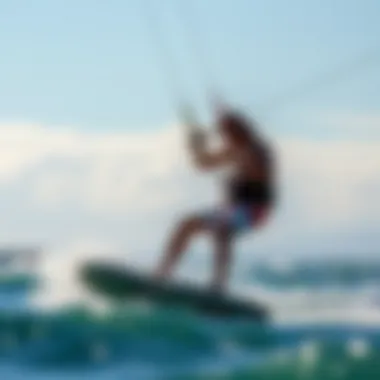
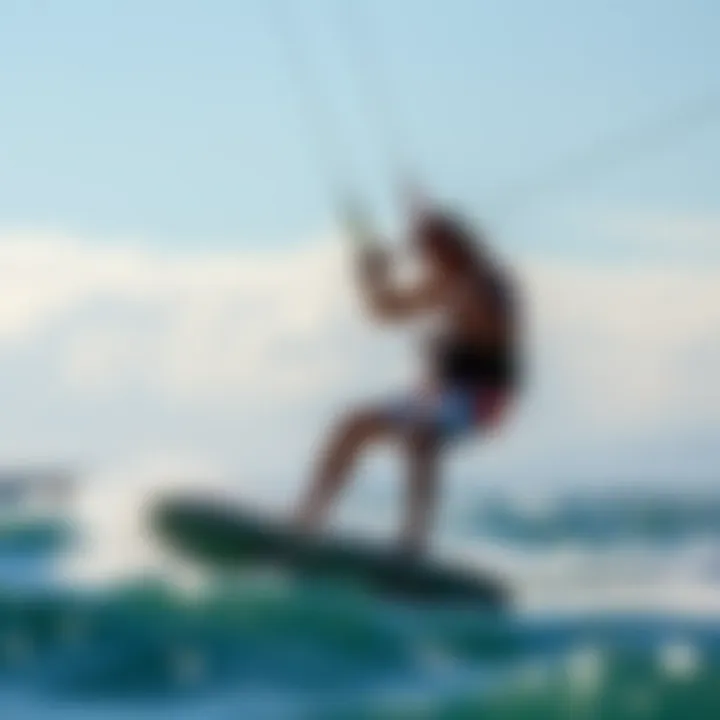
Establishing clear, achievable goals is the backbone of progressing in kitesurfing. This process allows you to track your enhancements and stay motivated. It’s much like climbing a mountain; you can’t tackle the peak all at once but you can set smaller milestones. Consider these elements:
- Specificity: Identify exact skills you wish to improve. For example, rather than just saying, "I want to ride better," say, "I want to master my water starts."
- Measurable Progress: Keep track of your advancements. You might note how many attempts it took to land a jump successfully.
- Realistic Timelines: Setting a timeline can keep you motivated without causing stress; perhaps aim for achieving that trick within a month.
Use visual aids like a notebook or a whiteboard to map your goals. This not only makes them tangible but also allows you to celebrate your wins.
Learning from Experienced Riders
One of the most invaluable resources in kitesurfing is the experience of others. Learning from seasoned riders can accelerate your progression significantly. Not only can they provide tips that are not readily available in books or online resources, but their firsthand experiences in various conditions can save you from making the same mistakes.
Consider joining local kitesurfing clubs or forums, like those found on reddit.com. Being part of a community allows for exchanging wisdom and experiences. You might even discover mentors among the more experienced riders who can offer to help you refine your techniques during practice sessions.
Attending Clinics and Camps
Immersive learning experiences like clinics and camps are a fantastic way to improve your skills rapidly. These programs are designed for various skill levels and often provide access to top-notch instructors. Engaging in a focused environment will help you:
- Get Personalized Feedback: Instructors can offer insights tailored specifically to your needs, while you will get immediate feedback on your performance.
- Network: Making connections with other kiteboarders can lead to long-lasting friendships, camaraderie, and future riding opportunities.
- Learn New Tricks: Group settings often create a fun atmosphere, fostering a spirit of encouragement and competition, which can be motivating.
Look for local clinics through community websites or check Facebook groups dedicated to kitesurfing. These events often highlight innovative techniques and can introduce you to the latest gear, which might also enhance your overall performance.
"Setting personal goals and learning from others are the cornerstones to advancing your kitesurfing abilities. Identify your path, and you will discover joy in every ride."
Progressing your skills in kitesurfing doesn’t just make you a better rider; it enriches your connection to the sport. Take the time to set goals, learn from experienced peers, and immerse yourself in the kiteboarding community through camps and clinics. With each step you take, you will find that the wind in your sails gets stronger.
The Community and Culture of Kitesurfing
The world of kitesurfing goes beyond just the thrill of riding waves and soaring through the sky. It's about the vibrant community that fosters a shared passion, where individuals create connections that often transcend geographical boundaries. Within this spirited network lies a culture rich in camaraderie, support, and encouragement. Engaging with fellow kiteboarders can not only enhance one’s skills but also bolster the overall experience of this exhilarating sport.
Finding Local Communities
Diving into the local kitesurfing scene necessitates an understanding of where to began. Every surf town and beach has its own vibe, often dictated by the local culture and the kinds of riders that populate the area. Finding local communities can be simplified by exploring specific kitesurfing spots known for their welcoming atmosphere.
- Join local clubs or schools: Many places have kiteboarding schools that regularly invite newcomers to join their sessions. These schools create a nurturing environment for those new to the sport, as experienced instructors often mix with budding enthusiasts.
- Attend meetups: Websites like facebook.com, meetup.com, or even local forums can connect you with other kitesurfers looking to share their experiences. These gatherings often include planned days out on the water.
- Word-of-mouth: Engaging the locals is often your best bet. A simple conversation at the beach can lead to valuable insights about the community, finding friends, or discovering hidden gems for kitesurfing.
Embracing local communities opens the door not just to enhanced riding skills, but also to friendship and support in what can sometimes be a challenging field. It helps to learn the lay of the land and the best practices from those who know it best.
Events and Competitions
Kitesurfing is also celebrated through a myriad of events and competitions, which serve as a showcase for talent and innovation while building a sense of community. Participating in or attending these events can inspire and motivate surfers at all levels.
- Local competitions: Many beaches host regional competitions, where riders get a chance to showcase their skills, cheer on peers, and even take home trophies. These events are great for observing how techniques are executed in real-time and learning from seasoned competitors.
- Festivals: Kitesurfing festivals often combine riding with music, food, and workshops. They create a festive environment, reinforcing the social aspect of the sport while offering different activities, such as yoga or dance workshops to ease the body and mind.
- International Championships: Bigger contests, like the Red Bull King of the Air, draw in top talent from around the globe. Watching these pros in action can elevate one's understanding of advanced techniques and inspire growth as a rider.
Engaging in these events allows one to witness the spirit of the community firsthand while offering networking opportunities and a chance to learn from those at the top of their game.
Social Media and Online Presence
In today’s world, social media is an essential component of kitesurfing culture. It creates a platform for sharing experiences, offering tips, and connecting with fellow enthusiasts globally.
- Instagram and Pinterest: These platforms are filled with breathtaking images and clips demonstrating remarkable skills. Following experienced riders can provide inspiration and insights into various styles and techniques.
- Online communities: Websites like reddit.com have dedicated threads for kitesurfers. These forums allow enthusiasts to discuss gear, techniques, and local spots while creating a sense of belonging among practitioners.
- Creating content: Many beginners and advanced riders alike start their own channels or blogs, sharing their learning journeys, trials, and triumphs. This not only fosters personal growth but also contributes to the collective knowledge pool available to newer riders.
Engaging with the online kitesurfing community allows for the sharing of experiences that can help others to advance in the sport, while also offering a sense of global kinship.
Social media isn’t just about showcasing the sport; it’s also a tool for education, connection, and community building. With a comprehensive online presence, every rider can feel a part of this thrilling sport, no matter their skill level.
Ending and Future Directions
When reflecting on the journey through the world of kitesurfing, it's essential to assess not only what has been learned but also what lies ahead. The realm of kiteboarding evolves continuously, precisely like the ever-changing wind conditions that define the sport. This section emphasizes the by the way power of kitesurfing to forge connections among diverse individuals and cultures while simultaneously urging riders to keep pushing their boundaries.
Reflecting on Initial Experiences
Initially, stepping onto the water with a kite can feel both thrilling and daunting. Riders often experience this rush, a mixture of nervousness and excitement. To progress effectively, one must acknowledge these early hurdles. Take a moment to reflect on those first rides; maybe it was the sense of freedom, the splash of saltwater, or learning how to control the kite. It’s vital to document those feelings, as they serve as a crucial foundation for future growth.
Start by asking yourself questions:
- What did I find most challenging?
- Which moments were the most enjoyable?
- How did I overcome my fears?
These reflections are not just sentimental musings; they can also guide your future endeavors. The initial experiences shape the base for skill development and foster resilience through minor setbacks, teaching that mastery comes with patience and practice.
Looking Forward in Kiteboarding
As you gaze into the horizon of kiteboarding, possibilities abound. This sport calls for innovation, not just on the water but also in techniques, equipment, and community engagement. Riders looking to elevate their game should consider:
- Exploring Advanced Techniques: Mastering jumps, tricks, or even racing can open doors to new experiences and challenges. Trying out new styles may lead one to discover their niche within this diverse sport.
- Staying Updated on Gear Advancements: Kite technology doesn’t rest, and neither should you. From lightweight materials to better safety features, always keep an eye on the latest innovations.
- Participating in Local Events: Engaging in local competitions or clinics is a fantastic way to meet seasoned riders and learn invaluable skills. Teach and be taught, as the community grows with collaboration.
- Fostering Sustainable Practices: With nature as our playground, it’s crucial to be mindful of environmental impacts. Show respect for local ecosystems and adopt sustainable practices which can elevate the sport’s community consciousness.
In summary, kitesurfing is a continuous journey of growth and exploration. Embrace those early days and allow them to thrill you forward into new skills and possibilities. The wind awaits, and so should your next adventure!















